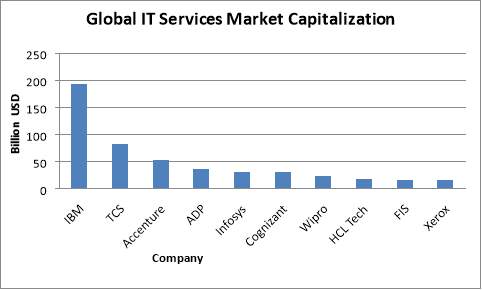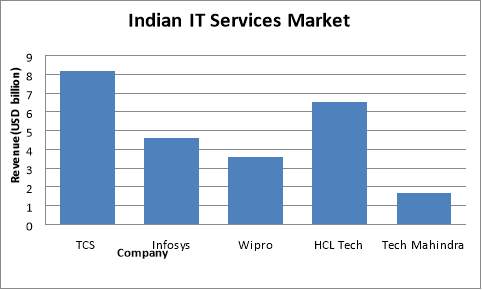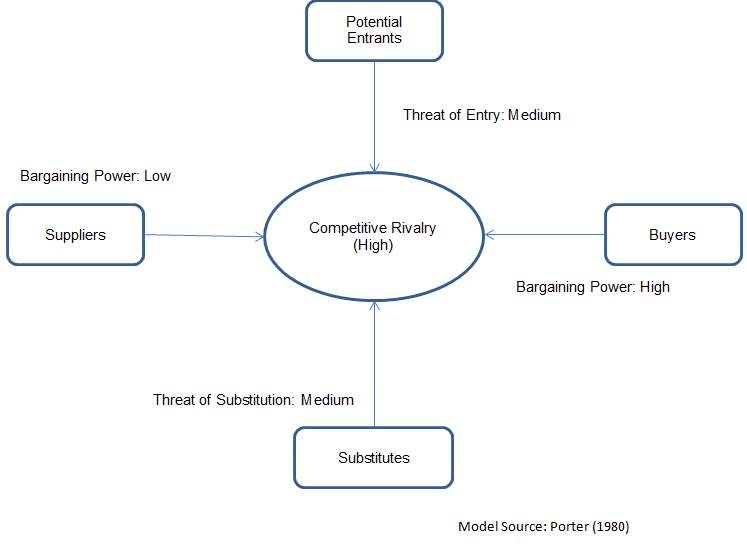Strategic Management –Tata Consultancy Services
Strategic Management –Tata Consultancy Services (ukdiss.com)
Introduction:
Strategic Management is the process of planning, monitoring and analysing the activities of an organization in order to accomplish the goal of the company (Andrews and Roland, 1987).It is the process of continuous planning which allows managers to analyse all strategies and cross functional business decisions before implementing them in workplace. This paper presents a detailed analysis of Tata Consultancy Services Limited, its strategies in past 10 years and rationale of choosing these strategies along with the critical evaluation of the strategic choice.
Analysis of Tata Consultancy Services:
Tata Consultancy Services (TCS) is a reputed subsidiary of Tata Group. It is an Indian firm which operates its business across the world. It provides extremely wide range of IT services, Business Consulting, Business Process Outsourcing (BPO), Engineering and Infrastructure to its corporate customers (TCS, 2017g) .The firm operates its business globally with more than 387,000 trained consultants(TCS, 2017f).For the year 2016, the firm has generated an revenue of 16545 Million USD with an growth rate of 14.8% (TCS, 2017b)
SWOT Analysis:
SWOT analysis is a tool that can help in identifying the external and internal factors that affect the organizations future performance (Pickton and Wright, 1998).TCS has many strengths and weaknesses and the same were explained below
Strengths:
- World’s powerful brand in IT services[1] rated by Brand Finance[2] (TCS, 2017h)
- Strong ethics which helps the firm in minimizing the future complexity and making the organization stronger. Its code of conduct shows the commitment of the service delivery to its customers (TCS, 2015).
- Clients from diversified markets by which the firm benefited in diluting its risk to greater extent (Andaleeb, 2016)
- Strong portfolio of various services and products which attracts more consumers towards the brand
- Strong financial performance. The firm has greater profits every year with good growth rate (TCS, 2010-17).
- Other strengths include cost advantage, strong management team and high level of customer relationship management (Lee et al., 2014)
Weaknesses:
- Majorly dependent on service sector of its business and less focused on Product development (TCS, 2017e)
- Majorly dependent on US and European markets even though it has operations in emerging economy countries (TCS, 2017e)
- Much dependent on Banking and Financial service sector[3] (TCS, 2017e)
- High number of experienced employees[4] which increases the employee cost of the company (TCS, 2017e)
Opportunities:
- Strong digital transformation technology is the major opportunity for TCS through which it can increase the revenue (IBEF, 2017)
- Cloud based solutions is another opportunity as this can help in protecting its digital services to great extent(IBEF, 2017)
- Expanding the firm operations to more emerging economies also gives the opportunity for TCS to increase its revenue.
Threat:
- Intense competition from Domestic and International firms is a major threat as it would become difficult for the firm to sustain the market for longer duration (IBEF, 2017)
- Changing IT laws in India and other countries are creating problems for the organization.(Rapoza, 2017)
- Economic slowdown globally is a great threat to TCS
- Rising Indian Rupee Value against US Dollar is impacting TCS revenues (Leahy)
- BREXIT to impact the future and current projects for TCS in EU Markets(Nadhe, 2016)
- Penalty from Law Suits [5] will impact the reputation and financial performance of the firm (Kumar, 2017)
Market Share of TCS:
TCS is the branded organization which has its operations in IT sector. “Experience Certainty” is the main slogan of TCS which shows that the firm is treating its customers well and trying to provide them extremely good services so that the customers retain with the brand for longer duration. TCS has become one of the top Global IT service providers (IBEF, 2017).

Data Source:(IBEF, 2017)
Above Graph shows the Market capitalization of IT service sector organizations for the Year 2016. TCS is standing in the 2nd position with the Market Capitalization of 82.45 bn USD. It is the first Indian IT firm to have huge revenue and capital across the world. TCS is ahead of many global competitors such as Accenture, Cognizant etc.

Data Source: (IBEF, 2017)
Above Graph Shows Revenue of the Indian IT Service Sector firms. TCS accounts nearly half of the Indian IT industry combined market capitalization. It is the leading IT player in India. It reported an revenue of 8.2 bn USD (April-September, 2015) (IBEF, 2017)
TCS Industry Verticals:
TCS offers IT Solutions to many industry clients such as banking, financial services, insurance, medical, rental, manufacturing and construction etc. It has done segmentation of enterprises that are seeking IT solutions
Revenue Breakup by Industry Vertical

Source: TCS (2017)
The above chart shows that TCS is much dependent on BFSI (Banking and Financial Services) which is threat to the organization. During the 2007-08 Global crises, Banking and Financial services sectors are largely impacted which in turn impacted other industries and IT industry is one among them. TCS experienced decline in its revenue in 2008 as it expected 42% of revenue from BFSI sector(TCS, 2008) .In year 2010, TCS announced that it is going to formulate an strategy for reducing its dependency on BFSI by pulling up the revenues from other industries (TCS, 2010) .But the above statistics shows that there is no major progress.
TCS manages all its verticals by allocating responsibilities to its employees as per their skills and abilities. There are three main levels of employee roles which are technical, managerial
and community level. Employees in all these levels work together to fulfil their responsibilities and targets. This organizational structure supports TCS in minimizing confusion and conflicts at the workplace (Oden and Nathdwara, 2014)
External Analysis of TCS:
External Environmental analysis is another important aspect of the organization as it helps the firms to ensure that they have fully addressed its current and future operating environments. This also helps the firms in formulating new strategies for gaining success in the market. This external analysis is often referred as PESTEL Analysis(Political, Economic, Social, Technological, Environmental and Legal influences) (Clegg et al., 2017)
Political Influences:
- Indian political structure is quite stable. Thus, TCS has high chance to grow well in Indian market. Government supports Information Technology entities by making new laws so that these firms can grow well and can contribute in the economic development of the nation (Agarwal and Al Farooque, 2016)
- TCS is also dependent on overseas markets majorly on US and European Markets. Political tensions such as BREXIT, Change in H1B US visa Processes (Protectionism) have greater impact on TCS projects (Nadhe, 2016)
Economic Influences:
- TCS has large workforce (more than 387000 employees) and the average compensation and benefits for the employees are higher which results in increase in the cost of operations (Lee et al., 2014).
- Demonetization in Inida which happened in 2016 has an impact over TCS Indian market(ICT, 2017)
- TCS increased local hiring in US and other countries[6] which in turn increased the cost of operations (Rapoza, 2017)
- TCS is availing tax benefits in India and other countries with the Special Economic Zone (SEZ) Scheme (IBEF, 2017)
- Increase in investment in IT sector is expected with the gain in the technology for Digital transformation of the Public Services, Healthcare, Education and other sectors which is an benefit for TCS (TCS, 2016)
Social Influences:
- Mode of education in India is majorly English which is helping TCS to recruit talented Graduates as they can easily communicate with Global Clients (IBEF, 2017)
- Risk of Labour shortage in India is very minimal(IBEF, 2017)
- TCS is involved in providing IT education to school and University level students as part of the Corporate Social Responsibility Activities (TCS, 2017d)
Technological Influences:
- Cloud computing, Mobility, Social media, Robotics and Big data (Digital 5 forces) to be the growth drivers for TCS (TCS, 2017b)
- TCS need to focus on Product based technologies and solutions rather than limiting its operations to service sector.
Environmental Influences:
- TCS has deployed smart metering in its Indian offices which resulted in the energy savings of 12.5 Million KWH (Reported FY16) (TCS, 2017c)
- Green Infrastructure, IT-enabled operational efficiencies and Green IT supports TCS energy management process. It has reduced Energy consumption by over 49% with these initiatives (TCS, 2017c)
Legal Influences:
- TCS has faced legal issues which will impact its reputation and brand image(Kumar, 2017)
- IT Laws in many countries are changing for overseas workers which are going to have an impact on TCS operating model.(Rapoza, 2017)
TCS Micro Environment Analysis using Porter Five Forces Framework

Competitive Rivalry: High
- Extensive Competition exists as more number of firms exists in the same industry. They compete for attracting the customers and resources. Rivalry between TCS and other major competitors like Infosys, HCL and Wipro is increasing since they compete for the market share as well (IBEF, 2017).
- Currently, Growth in IT sector is medium (after 2008 Global Crisis).So, firms competing to increase their revenues by capturing the growth markets or Emerging Markets.
- Switching costs in IT industry is low. This factor results in increase in the rivalry since the customer can easily switch to other firms(Dave and Wolak, 1997).
- Other factors such as Low exit barriers and less investment also results in increase in rivalry(Dave and Wolak, 1997).
Threat of Entry: Medium
- Capital requirement of entry is Low. So new firms can easily enter the industry. Also, the industry is unattractive to new firms because of the strong retaliation from existing players like TCS, Infosys etc(Kumar, 2014).
- Economies of scale are high. Services can be delivered with relatively low costs(Kumar, 2014)
- Differentiation plays a major role for the new firms to capture or sustain in the IT market. If the firm has brand new ideas that can attract the customers then the firm can be successful.
Over all, Threat of entry to IT industry is Medium .It is easy to enter but difficult to establish and sustain for longer durations.
Threat from Substitutes: Medium
- There are no significant substitutes for providing IT solutions. However, firms in china and Philippines are having low cost advantages when compared to TCS which may attract more stakeholder .However, efficiency and reliability of those low cost firms are always questionable. Over all, the threat from substitutes is moderate(IBEF, 2017)
Bargaining Power of Suppliers: Low
- Microsoft, Oracle, Dell are the main suppliers for TCS .They provide software, Hardware and other databases for TCS to perform its operations. The bargaining power of suppliers is relatively low since TCS has made them as strategic partners(TCS, 2017a) (See Appendix 1).
Bargaining Power of Buyers: High
- Intense competition and Growing number of new firms in IT industry results in increase in the Bargaining power of customers(IBEF, 2017).
- There are many choices for the customers in choosing the firm. They can easily switch from one company to other since the switching costs are relatively low (IBEF, 2017).
- Most of the firms in this industry compete for the same customer projects(IBEF, 2017).
Over all, it is clear that more number of firms in IT industry is leading to High Bargaining power of customers.
[1] TCS has been rated AA+ with 78.3 brand strength index which is highest in the IT Services Industry
[2] Global Brand Valuation firm
[3] More than 40% of the company revenue is from Banking and Financial sector
[4] More than 387,000 employees
[5] Eg : Legal issues with Epic systems in 2016
[6] Due to the changes in immigration policies. TCS overseas employee get a pay approximately twice when compared to Indian employee
Comments
Post a Comment